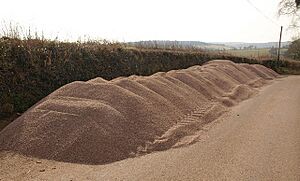Gravel facts for kids
Gravel is made of small, loose pieces of rock. It's basically any loose rock that is bigger than 2 millimeters (about 1/12 of an inch) but no larger than 64 millimeters (about 2.5 inches). Think of it as tiny rocks that aren't stuck together.
Smaller pieces of gravel are called granules. These are usually between 2 and 4 millimeters in size. Larger pieces of gravel are known as pebbles. Pebbles are bigger, ranging from 4 to 64 millimeters.
If the rock pieces are smaller than gravel, they are called sand. If they are much larger than gravel, they are known as cobbles.
Gravel is very useful! It's often used to build roads. It's also a key ingredient in things like cement and Tarmac, which are used for building and paving. When gravel and sand are mixed with other crushed materials, this mix is called aggregate. Aggregate is used for many things, like helping water drain away under roads. Sometimes, stones and a special sticky resin are mixed together to make smooth paths and driveways. This is called Resin Bonded Gravel.
Where Does Gravel Come From?
Natural gravel often comes from very old beaches. These are beaches that have not turned into solid rock over time. Imagine digging up a beach that existed millions of years ago, perhaps during the Jurassic period! This material is found in special places called quarries.
Once dug up, the gravel is carefully sorted by size. Then, it's sold to engineering companies for their projects. Most natural sand and gravel is made of silica. This material is very strong and lasts a long time.
Sometimes, gravel is made by crushing large, solid rocks. This allows companies to create gravel from different types of rock, like granite or limestone. These rocks were once solid but are crushed into smaller pieces to become gravel.
The process of digging up and preparing gravel, sand, and aggregate is a huge business all over the world. It's sometimes called the "conglomerates" industry.
Images for kids
See also
 In Spanish: Grava para niños
In Spanish: Grava para niños







